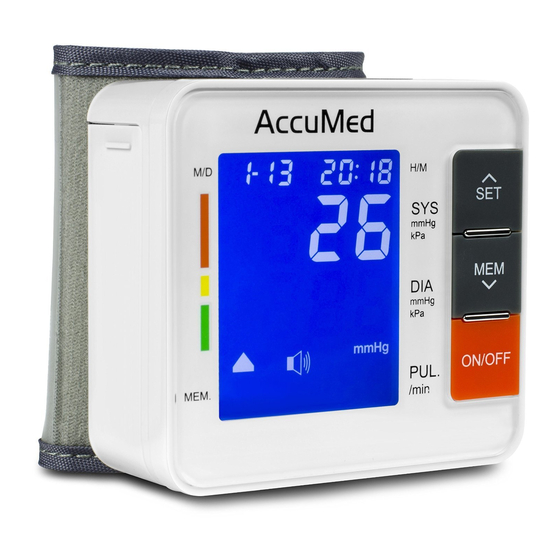
Table of Contents
Advertisement
Quick Links
Advertisement
Table of Contents

Summary of Contents for AccuMed ABP801
- Page 1 WRIST BLOOD PRESSURE MONITOR Instruction Manual MODEL: ABP801 www.AccuMed.com...
-
Page 2: Table Of Contents
TABLE OF CONTENTS INTRODUCTION ......................... 1 NOTES ON SAFETY ......................1 ABOUT BLOOD PRESSURE ....................3 PRECAUTIONS BEFORE US ..................... 4 FEATURES OF THE PRODUCT ..................4 PARTS IDENTIFICATION ....................5 INSERT OR REPLACE BATTERIES................... 5 TIME AND VOICE ON/OFF OF SYSTEM SETUP .............. 6 UNIT CONVERSION mmHg/kPa DISPLAY ................ -
Page 3: Introduction
INTRODUCTION The Monitor uses the oscillometric method of blood pressure measurement. Measurement Automatic Electronic Blood Pressure Monitor is intended for use by medical professionals or at home to monitor and display diastolic, systolic blood pressure and pulse rate, with an air wrist cuff buckled around one’s wrist according to the instructions in the “ATTACHING THE WRISTCUFF”... - Page 4 Patient must follow doctor’s instruction and should not perform self-judgment and self-treatment by the measuring result. Self-diagnosis of measured results and treatment are dangerous. The device should not be used to judge illness, first aid, and continuously measuring. This device cannot be used for patient transport and surgical care.
-
Page 5: About Blood Pressure
ABOUT BLOOD PRESSURE 1. What is blood pressure? Blood pressure is the force exerted by blood against the walls of the arteries. Systolic pressure occurs when the heart contracts. Diastolic pressure occurs when the heart expands. Blood pressure is measured in millimeters of mercury (mmHg). One's natural blood pressure is represented by the fundamental pressure, which is measured first thing in the morning while one is still at rest and before eating. -
Page 6: Precautions Before Us
Take measurements at the same time every day using the procedure described in this manual to determine your normal blood pressure. Many readings give a more comprehensive blood pressure history. Be sure to note date and time when recording your blood pressure. Consult your doctor to interpret your blood pressure data. -
Page 7: Parts Identification
PARTS IDENTIFICATION INSERT OR REPLACE BATTERIES 1. Remove the battery cover. 2. Insert new batteries into the battery compartment as shown, taking care that the polarities (+) and (-) are correct. 3. Close the battery cover. Use only LR03, AAA batteries. Dispose of dead batteries to the authorized collecting party according to the regulation of each individual territory. -
Page 8: Time And Voice On/Off Of System Setup
* lf you are not going to use the unit for a long period of time (approximately three months or more), remove the batteries. * Replace worn batteries with their polarities in the correct direction. TIME AND VOICE ON/OFF OF SYSTEM SETUP 1. -
Page 9: Who Blood Pressure Classification Display
WHO BLOOD PRESSURE CLASSIFICATION DISPLAY Diastolic blood pressure reference material: journal of hypertension 1999. Vol 17 No.2 ATTACHING THE WRIST CUFF 1. Fastening the wrist cuff 1) Wrap the wrist cuff around your wrist about (1-2) cm away from your hand as shown in the figure at the right. -
Page 10: Care And Maintenance
READ MEMORY Press the “MEM” button to view the last measurement recorded. Press the “MEM” button again to go through older records. Press the “SET” button to go to more recent records. The number next to “M” on the screen indicates which record it is. The larger the number is, the older the record. -
Page 11: Specifications
* Remove the batteries if the unit will not be used for three months or longer. Always replace all the batteries with new ones at the same time. This product is designed for use over an extended period of time; however, it is generally recommended that it be inspected and calibrated every two years to ensure proper function and performance. -
Page 12: Troubleshooting
MODEL ABP801 as replacement parts for internal components, may result in increased EMISSIONS or decreased IMMUNITY of the MODEL ABP801. 2. Warning that the MODEL ABP801 should not be used adjacent to or stacked with other... - Page 13 Guidance and manufacturer’s declaration – electromagnetic emissions The MODEL ABP801 is intended for use in the electromagnetic environment specified below. The customer or the user of the MODEL ABP801 should assure that it is used in such an environment. Emissions...
- Page 14 AM and FM radio broadcast, and TV broadcast cannot be predicted theoretically with accuracy. To assess the electromagnetic environment due to fixed RF transmitters, an electromagnetic site survey should be considered. If the measured field strength in the location in which the MODEL ABP801 is used exceeds the...
- Page 15 RF compliance level above, the MODEL ABP801 should be observed to verify normal operation. If abnormal performance is observed, additional measures may be necessary, such as re-orienting or relocating the MODEL ABP801. b. Over the frequency range 150 kHz to 80 MHz, field strengths should be less than 3 V/m.


Need help?
Do you have a question about the ABP801 and is the answer not in the manual?
Questions and answers